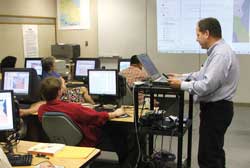Training First Responders
The events surrounding the terrorist attacks in New York City and Washington, D.C., in 2001 and, more recently, the effects of Hurricanes Katrina and Rita have clearly demonstrated the need for geospatial skills in emergency response and planning communities at the national level.
The need has been recognized by the inclusion of geospatial technology as one of the important emerging industries listed in President George W. Bush's High Growth Job Training Initiative. In response to this need for geospatial awareness and training for first responders, the Geographic Information Systems Technology Implementation Project (GIS-TECH) hosted by Del Mar College (DMC) in Corpus Christi, Texas, has created a 48-hour course. Developed as a component of the GIS-TECH project, this course is funded by the National Science Foundation (NSF).
A consortium of schools and organizations, led by DMC, is developing coursework that covers building and converting large relational databases, installing GIS data servers, and effectively using GIS for domain-specific applications. It is headed by DMC computer science professor Phillip Davis.
The Introduction to GIS for Incident Command and Control First Responders course consists of a series of three two-day workshops held in March, April, and May 2006 so participants had ample opportunity between sessions to practice newly acquired GIS skills. The course, developed by Mike Price with help from Ann Johnson and taught by Price and Ronnie Coleman, retired fire chief for the City of Roseville, Texas, was designed around the ArcInfo 9.1 suite of GIS tools from Esri. It trains first responders in how to use GIS in planning, preparing, and responding to emergencies.
 |
| Mike Price (above), GIS consultant and ArcUser contributor, and Ronnie Coleman, (below) retired fire chief for the City of Roseville, Texas, taught the Introduction to GIS for Incident Command and Control First Responders course at Del Mar College. |
 |
Price, president of Entrada/San Juan, Inc., is a geologist and GIS specialist who provides consulting services for GIS applications in geology, natural resources, and public safety. Johnson is the higher education manager for Esri and coprincipal investigator of the GIS-TECH project team.
The course was created specifically for first responders in Nueces County, located in eastern Texas along the Gulf Coast. However, the exercises can be easily adapted for any location where TIGER census, United States Geological Survey Seamless Data Distribution System, and Insurance Services Office data is readily available. The lab uses a geodatabase designed to train emergency response command and control personnel in Nueces County. The participants were all new to ArcGIS, which presents a special challenge to even a skilled trainer like Price. Del Mar College provided two experienced GIS teachers to assist Price during all six days of classroom training. The lab required extensive updating to prepare the data files and software for each subsequent workshop.
Course participants included members of the Corpus Christi Fire Department's Education Office, the Nueces County Emergency Services District 2, the Nueces County Parks Department, the Texas Commission on Environmental Quality, the National Weather Service, the Port Mansfield Volunteer Fire Department, the Local Emergency Planning Committee, and the Nueces County Appraisal District as well as the San Patricio County E-911 coodinator.
The course, divided into three modules, was designed to be completed in 16-hour increments. These modules use
- TIGER data to create a basemap
- Seamless data to add relevant layers to the basemap.
- The ArcGIS Network Analyst extension to create response time zones and best-route response maps.
By the end of the course, participants were able to demonstrate a variety of geospatial skills relating to customizing maps:
- Locate, download, process, and add ISO and census TIGER data.
- Define data projections.
- Create metadata.
- Associate labels using Census Feature Class Codes.
- Store spatial and tabular data in a geodatabase.
- Locate fire stations by GPS coordinates and street addresses.
- Load and analyze time-based response networks.
- Create display maps from TIGER and other data.
At the conclusion of the course in May, each participant had created a customized map of Nueces County that depicted the location of fire stations, hospitals, facilities, and response routes. Each participant was provided an evaluation copy of Esri ArcGIS ArcView 9.1 and its extensions and a CD with a Nueces County TIGER map for educational purposes. With these new skills, participants can now apply GIS when planning for and responding to emergencies.
The Introduction to GIS for Incident Command and Control First Responders course is a good start in preparing the nation's first responders to minimize and mitigate future disasters. The need for such preparation is particularly acute in Nueces County, which is home to the Port of Corpus Christi—the nation's fifth largest seaport and a major petroleum port that hosts petrochemical refineries and two major liquefied natural gas terminals that should be completed in 2008 and 2010. With above-average hurricane activity forecast for this decade, the need for a highly trained emergency response workforce has never been greater. For more information about the project and training materials, please contact Phillip Davis at pdavis@delmar.edu.
|